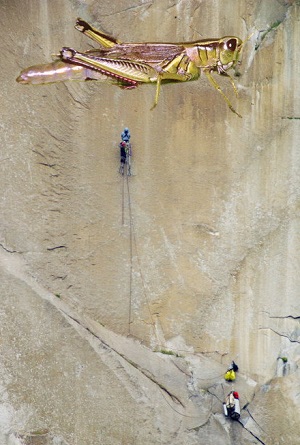 Can one person climb the thousands of vertical feet of El Capitan eating just bugs? I’ll find out this September, when I spend 2 weeks climbing El Capitan in Yosemite National Park with just myself, hundreds pounds of gear and lots of bugs! Big wall climbing can be a brutal genera of climbing, solo big wall climbing is an even more taxing task. I will need a steady supply of quality calories; edible insects are the perfect solution for endurance intensive pursuits like big walls. Follow my demise into nuttery; daily trip reports, photos, BugWall recipes, and videos will be uploaded to bugvivant.com, #BugWall. Climbing footage will be uploaded to YouTube after the climb.
Can one person climb the thousands of vertical feet of El Capitan eating just bugs? I’ll find out this September, when I spend 2 weeks climbing El Capitan in Yosemite National Park with just myself, hundreds pounds of gear and lots of bugs! Big wall climbing can be a brutal genera of climbing, solo big wall climbing is an even more taxing task. I will need a steady supply of quality calories; edible insects are the perfect solution for endurance intensive pursuits like big walls. Follow my demise into nuttery; daily trip reports, photos, BugWall recipes, and videos will be uploaded to bugvivant.com, #BugWall. Climbing footage will be uploaded to YouTube after the climb.
UPDATE: Bug Wall is Back On, and Better than Ever!
Mark your calendars for September 28th
Great news, the BugWall is back on and better than ever! Not long after announcing the BugWall last April, I learned that my father had unexpectedly passed away. Thank you all very much for your support during this time. Im now fired up to resume the BugWall this fall, with a few added bonuses. Keep an eye out for:
- Little Herds – BugWall crowdfunding campaign with thousands of dollars in donated perks (launches Sept 9th)
- BugWall specific recipes
- Demo of brand new, top secret edible insect products
A big thanks to our Awesome BugWall sponsors
Stay tuned for recipes, test runs, and loads of perks on our Little Herds – BugWall crowdfunding campaign from these gracious donors.
- Next Millennium Farms
- Hopper
- C-Fu
- Bug Eater Foods
- Aspire FG
- Cricket Flours
- Exo
- Bitty
- Chapul
- Crik Nutrition
- Six Foods
- Eat Yummy Bugs
For BugWall updates, subscribe to our newsletter
Why climb a Bug Wall?
- First and foremost, I want to promote edible insects. Climbing a BugWall is a unique way to combine my love of rock climbing and entomophagy.
- Get adequate nutrition! Solo climbing the big wall route Zodiac 4 years ago was the hardest thing I’ve ever done and it is only 2/3 rds the size of the BugWall route Mescalito. On a typical wall (sans edible insects), I lose 5-10% of my body weight and end up with deep ridges in my nail bed signaling a massive nutritional deficit. Edible insects are the perfect protein and nutrient rich big wall food to keep me going for 2 hard weeks.
- Climbing in BugWall Style will allow me to stay more connectected. Soloing a big wall can be really isolating – you spend weeks totally alone, physically and mentally exhausted on a daily basis. On the BugWall, however, I will bring my smart phone and solar charger so that each night after climbing so that I can share my experiences with you all.
Why is El Capitan a big deal?
If you’ve been to Yosemite, nothing needs to be said. Towering thousands of feet above a lush meadow, El Capitan is considered to be the most striking formation in all of Yosemite National Park. For many climbers its the perfect combination of stunning scenery and superb glacier-polished granite; Yosemite is the promise land and El Cap is the holy grail. Until 1958, it was considered impossible to climb before Warren Harding made a dramatic 47 day assent. Since then, El Cap has seen thousands of inspiring ascents and failed attempts. In the center of one of America’s most popular national parks, climbers on El Cap provide an unexpected spectacle for Yosemite tourists on El Cap meadow.
#BugWall Buzz
What type of climbing is aid climbing?
For the non climber the differences between different climbing styles can seem pretty minor. Who cares if a climber clips pre-placed bolts, climbs the move freely, or pounds a piton into the rock? To climbers, however, these seemingly minor differences in style have sparked decades of debate. Different types of climbing used to climb El Capitan include:
BugWall = Aid Climbing + Rope Soloing + Bugs
Aid climbing = using a rope and gear to move upwards, placing climbing protection pieces into cracks, then pulling on them to move upwards because the rock is to difficult to physically climb with just hands and feet. This is the most common style of El Cap climbing because most of the long faces have very small holds to hang onto and are very steep. Aid climbing is much slower and requires a great deal more climbing gear and technical knowledge than free climbing. Mescalito has never been free climbed.
Free climbing = using a rope and gear to move upwards, climbing only on the rock, not pre-placed climbing gear. This style of climbing was recently made famous by Tommy Caldwell and Kevin Jorgeson’s assent of Dawn Wall, but is an uncommon style of climbing used to summit El Capitan’s longer routes.
Rope soloing = aid climbing or free climbing with ropes, but without a partner. This is a technically advanced way to climb alone. Scroll down to learn the finer points of a rope solo aid climbing.
Free soloing = climbing without a rope – its just as scary as it sounds.
More info about different climbing types.
How do you aid climb with no partner?
Aid climbing is basically vertical backpacking. It involves gobs and gobs of climbing gear to be carried by the climber; 20-35 pounds of protection pieces and another 5-10 pounds of pulleys, mechanical ascenders, and nylon ladders, all of which hang on the climber from chest slings and climbing harnesses. All of this gear, the climber and even more food water and shelter items must be moved up the wall vertically. Solo aid climbing is so taxing because one climber must perform all the below tasks 2-4 times per day. Mescalito (the BugWall route on El Capitan) is 26 ‘pitches’ or individual sections of rock separated by anchor points. To solo aid 1 pitch …
- From the ground, set a ground anchor to hold a upward directional pull. Attach one end of the rope to the ground anchor.
- Attach the rope to your harness with an assisted braking device (something that grab the rope if I fall).
- Place a piece of climbing gear in a crack, attach a ladder to it, stand up in the ladder.
- While standing in the ladder on the last piece of climbing gear, place another one higher in the crack. Attach another ladder to the new piece of gear and stand in the new ladder.
- Remove the first ladder and repeat 20-40 times per rope length until reaching the next anchor point.
- Tie your rope to the new anchor point.
- On a separate rope that you carried up, rig a hauling system for the 150-200 pounds of bugs, water, and sleeping equipment.
- Rappel down the rope you used to climb up.
- Make sure the haulbags a.k.a. pigs are ready to be hauled.
- Using ascenders, ascend the rope cleaning all of the climbing gear left in the crack.
- Reach the first anchor, then haul the very very heavy pigs up using a system of pulleys – the least pleasant big wall task.
- Rearrange the gear and ropes for the next pitch.
- Repeat another 1-3 more times per day until your ready to set up your portaledge, feast on some edible insects, send some Tweets, and fall fast asleep!
How do you sleep up there?
Sleeping on a wall is really fun. You get to sleep comfortably in a portaledge (a hanging cot with no legs) suspended thousands of feet above the ground from an anchor point. Depending on the weather, a portaledge fly (like a tent fly) can keep out bad weather. Long days of vertical toil are rewarded with nearly all the trappings of a backpacker’s camp minus the ground!
My favorite wall question: how do you go to the bathroom up there?
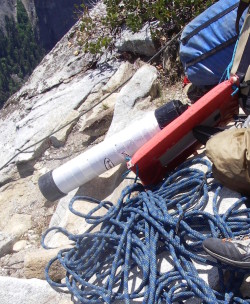 Decades ago, climbers paid little mind to trash and waste raining down on El Capitan. As climbing traffic on El Cap increased so too did a terrible waste pile at the base. A few climbers have even been hit by falling bags of human waste. It only takes a few bags of poop to the face to inspire an ethical shift in big wall waste management practices. Today we pack out what we pack in, including waste = poop tubes! Don’t worry, no one actually poops into a tube. A poop tube is sturdy PVC case that is only used to safely store WAG bags used collect human waste.
Decades ago, climbers paid little mind to trash and waste raining down on El Capitan. As climbing traffic on El Cap increased so too did a terrible waste pile at the base. A few climbers have even been hit by falling bags of human waste. It only takes a few bags of poop to the face to inspire an ethical shift in big wall waste management practices. Today we pack out what we pack in, including waste = poop tubes! Don’t worry, no one actually poops into a tube. A poop tube is sturdy PVC case that is only used to safely store WAG bags used collect human waste.
What route will I climb?
Mescalito is a steep sustained aid route cutting up the center of El Capitan. The aid climbing will be tricky and likely require the use of a hammer, pitons, and possibly ‘bashies’. Though I have climbed aid pitches of this difficulty in the past, I have never climbed this grade without a partner or on such a long route. Mescalito is 26 pitches long (2700 feet of climbing) which will likely take 10-14 days to rope solo this aid climb.
Bugs get Vertical, Big Walls go sustainable: time to think about bugs in a big way.
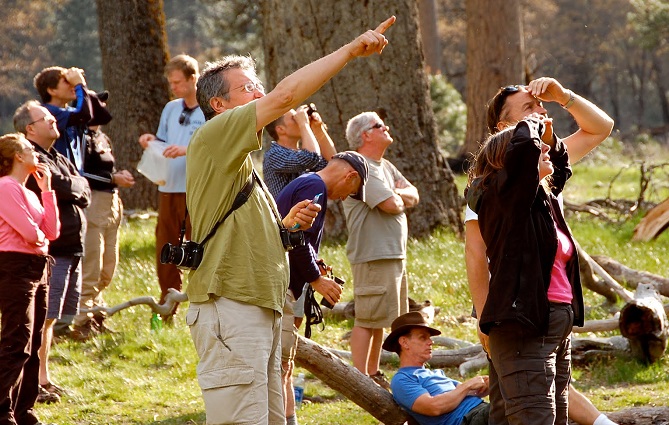
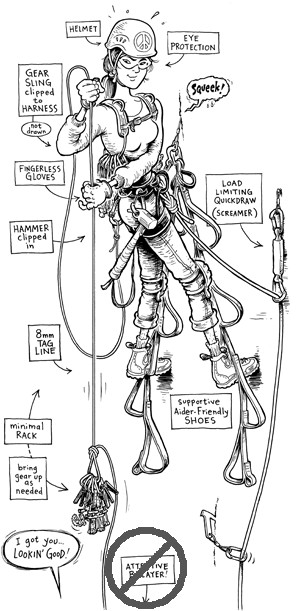
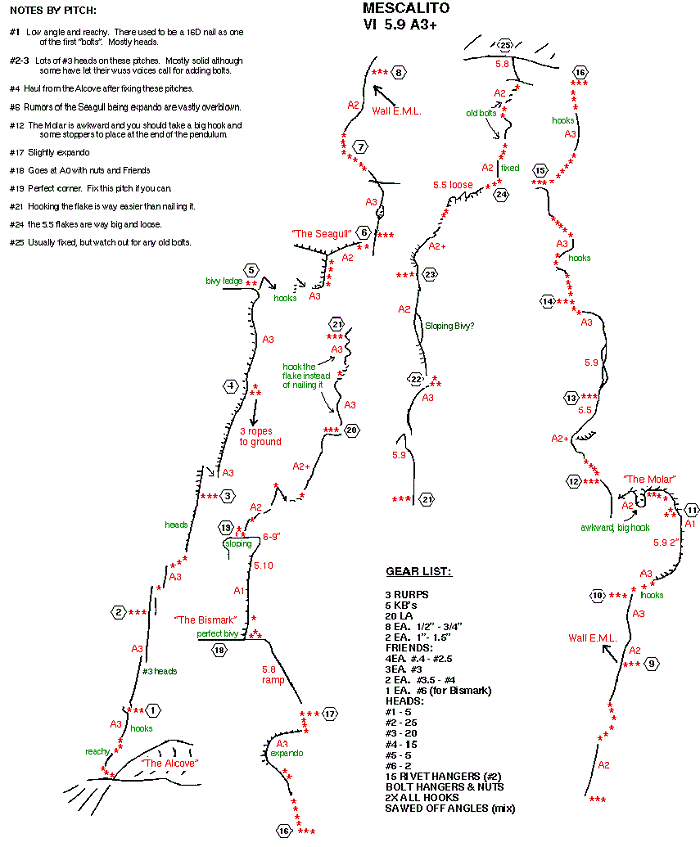
What a great idea! Are you videoing the climb too?
Good luck!
Hi Chris, Yes. I plan to wear a GoPro to video tape bug dinners and dicey aid pitches. I probably won’t have the ability to upload the HD video while climbing, but will create some short films when I get down.
Meghan, I am really looking forward to this. I wish you the best of luck.